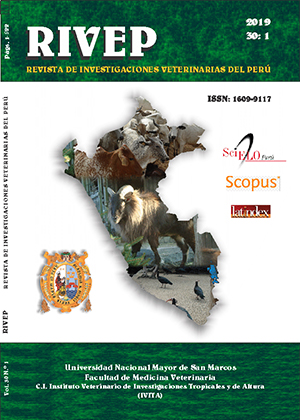Hematological parameters of the suri (Rhea pennata) in conditions of captivity in the Peruvian high plateau
DOI:
https://doi.org/10.15381/rivep.v30i1.15676Keywords:
hematology; female; male; ageAbstract
The aim of this study was to evaluate the hematological constants of the red and white series in suri (Rhea pennata) in captivity in the Peruvian high plateau, considering, in addition, the sex and age variables. Sampling was done on 28 individuals from the Lupaca Rescue Center, El Collao province, Puno region, Peru, at 4530 m. The birds were 14 females and 14 males, corresponding to seven juveniles (12-23 months) and seven adults (more than 24 months) in each case. The animals were apparently healthy. The blood samples were obtained after fasting in the morning by puncture in the axillary vein. The count of erythrocytes and leukocytes was determined using the Neubauer hemocytometer, the Natt-Herrick solution and blood smear stained with the Wrigth stain, hematocrit by microhematocrit, and hemoglobin by spectrophotometry using the cyanometahemoglobin method. The hematological values between females and males were similar. The hematocrit found in juveniles was higher in 10%, the heterophiles in more than 5% and lymphocytes in 8% with respect to adults (p<0.05), while monocytes and eosinophils were 5 and 9% higher, respectively, in adults as compared to juveniles (p<0.05).
Downloads
Downloads
Published
Issue
Section
License
Copyright (c) 2019 Ludwing Á. Cárdenas-Villanueva, Vitaliano Valeriano-Pari, Martha M. Hancco-Gamarra, Pedro Coila-Añasco

This work is licensed under a Creative Commons Attribution-NonCommercial-ShareAlike 4.0 International License.
AUTHORS RETAIN THEIR RIGHTS:
a. Authors retain their trade mark rights and patent, and also on any process or procedure described in the article.
b. Authors retain their right to share, copy, distribute, perform and publicly communicate their article (eg, to place their article in an institutional repository or publish it in a book), with an acknowledgment of its initial publication in the Revista de Investigaciones Veterinarias del Perú (RIVEP).
c. Authors retain theirs right to make a subsequent publication of their work, to use the article or any part thereof (eg a compilation of his papers, lecture notes, thesis, or a book), always indicating the source of publication (the originator of the work, journal, volume, number and date).



